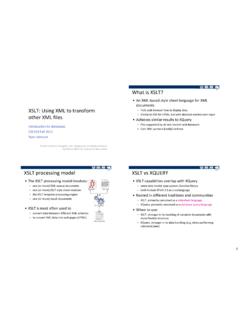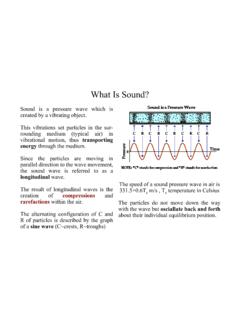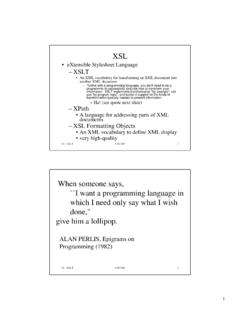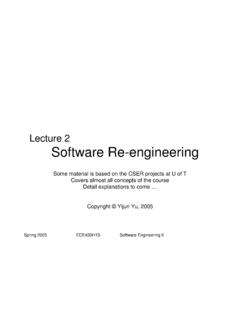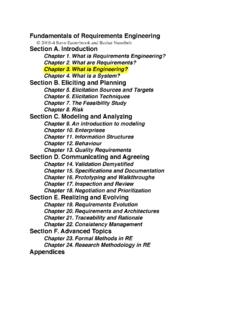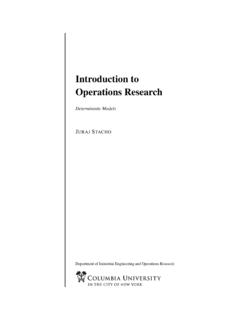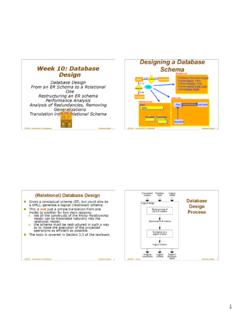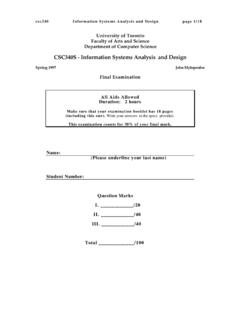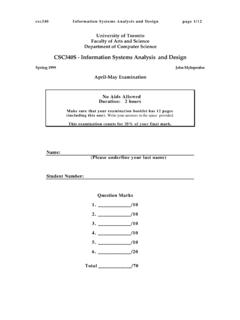Transcription of University of Toronto Lecture 7: Why a feasibility …
1 1 University of TorontoDepartment of Computer Science 2004-5 Steve Easterbrook. This presentation is available free for non-commercial use with attribution under a creative commons license. 1 Lecture 7:the feasibility Study What is a feasibility study? What to study and conclude? Types of feasibility Technical Economic Schedule Operational Quantifying benefits and costs Payback analysis Net Present Value Analysis Return on Investment Analysis Comparing alternativesUniversity of TorontoDepartment of Computer Science 2004-5 Steve Easterbrook. This presentation is available free for non-commercial use with attribution under a creative commons license. 2 Why a feasibility study? Objectives: To find out if an system development project can be done: ..is it possible? ..is it justified? To suggest possible alternative solutions. To provide management with enough information to know: Whether the project can be done Whether the final product will benefit its intended users What the alternatives are (so that a selection can be made in subsequent phases) Whether there is a preferred alternative A management-oriented activity: After a feasibility study, management makes a go/no-go decision.
2 Need to examine the problem in the context of broader business strategyUniversity of TorontoDepartment of Computer Science 2004-5 Steve Easterbrook. This presentation is available free for non-commercial use with attribution under a creative commons license. 3 Content of a feasibility study Things to be studied in the feasibility study: The present organizational system Stakeholders, users, policies, functions, objectives,.. Problems with the present system inconsistencies, inadequacies in functionality, performance,.. Goals and other requirements for the new system Which problem(s) need to be solved? What would the stakeholders like to achieve? Constraints including nonfunctional requirements on the system (preliminary pass) Possible alternatives Sticking with the current system is always an alternative Different business processes for solving the problems Different levels/types of computerization for the solutions Advantages and disadvantages of the alternatives Things to conclude: feasibility of the project The preferred of TorontoDepartment of Computer Science 2004-5 Steve Easterbrook.
3 This presentation is available free for non-commercial use with attribution under a creative commons license. 4 Exploring feasibility The PIECES framework Useful for identifying operational problems to be solved, and their urgency Performance Is current throughput and response time adequate? Information Do end users and managers get timely, pertinent, accurate and usefullyformatted information? Economy Are services provided by the current system cost-effective? Could there be a reduction in costs and/or an increase in benefits? Control Are there effective controls to protect against fraud and to guaranteeinformation accuracy and security? Efficiency Does current system make good use of resources: people, time, flow of forms,..? Services Are current services reliable? Are they flexible and expandable?See the course website for a more specific list of PIECES questions2 University of TorontoDepartment of Computer Science 2004-5 Steve Easterbrook.
4 This presentation is available free for non-commercial use with attribution under a creative commons license. 5 University of TorontoDepartment of Computer Science 2004-5 Steve Easterbrook. This presentation is available free for non-commercial use with attribution under a creative commons license. 6 Technical feasibility Is the project possible with currenttechnology? Economic feasibility Is the project possible, givenresource constraints? Schedule feasibility Is it possible to build a solution intime to be useful? Operational feasibility If the system is developed, will it beused?Four Types of feasibility Technical feasibility Is the project possible with currenttechnology? What technical risk is there? Availability of the technology: Is it available locally? Can it be obtained? Will it be compatible with othersystems? Economic feasibility Is the project possible, givenresource constraints?
5 What are the benefits? Both tangible and intangible Quantify them! What are the development andoperational costs? Are the benefits worth the costs? Schedule feasibility Is it possible to build a solution intime to be useful? What are the consequences of delay? Any constraints on the schedule? Can these constraints be met? Operational feasibility If the system is developed, will it beused? Human and social Potential labour objections? Manager resistance? Organizational conflicts and policies? Social acceptability? legal aspects and governmentregulations? University of TorontoDepartment of Computer Science 2004-5 Steve Easterbrook. This presentation is available free for non-commercial use with attribution under a creative commons license. 7(1) Technical feasibility Is the proposed technology or solution practical? Do we currently possess the necessary technology?
6 Do we possess the necessary technical expertise ..and is the schedule reasonable for this team? Is relevant technology mature enough to be easily applied to our problem? What kinds of technology will we need? Some organizations like to use state-of-the-art technology ..but most prefer to use mature and proven technology. A mature technology has a larger customer base for obtaining adviceconcerning problems and improvements. Is the required technology available in house ? If the technology is available: ..does it have the capacity to handle the solution? If the technology is not available: ..can it be acquired? University of TorontoDepartment of Computer Science 2004-5 Steve Easterbrook. This presentation is available free for non-commercial use with attribution under a creative commons license. 8(2) Economic feasibility Can the bottom line be quantified yet? Very early in the a judgment of whether solving the problem is worthwhile.
7 Once specific requirements and solutions have been ..the costs and benefits of each alternative can be calculated Cost-benefit analysis Purpose - answer questions such as: Is the project justified ( will benefits outweigh costs)? What is the minimal cost to attain a certain system? How soon will the benefits accrue? Which alternative offers the best return on investment? Examples of things to consider: Hardware/software selection Selection among alternative financing arrangements (rent/lease/purchase) Difficulties benefits and costs can both be intangible, hidden and/or hard to estimate ranking multi-criteria alternatives3 University of TorontoDepartment of Computer Science 2004-5 Steve Easterbrook. This presentation is available free for non-commercial use with attribution under a creative commons license. 9 Benefits Costs Tangible Benefits Readily quantified as $ values Examples: increased sales cost/error reductions increased throughput/efficiency increased margin on sales more effective use of staff time Intangible benefits Difficult to quantify But maybe more important!
8 Business analysts help estimate $ values Examples: increased flexibility of operation higher quality products/services better customer relations improved staff morale How will the benefits accrue? When - over what timescale? Where in the organization? Development costs (OTO) Development and purchasing costs: Cost of development team Consultant fees software used (buy or build)? hardware (what to buy, buy/lease)? facilities (site, communications, power,..) Installation and conversion costs: installing the system, training personnel, file conversion,.. Operational costs (on-going) System Maintenance: hardware (repairs, lease, supplies,..), software (licenses and contracts), facilities Personnel: For operation (data entry, backups,..) For support (user support, hardware andsoftware maintenance, supplies,..) On-going training costsUniversity of TorontoDepartment of Computer Science 2004-5 Steve Easterbrook.
9 This presentation is available free for non-commercial use with attribution under a creative commons license. 10 Example: costs for small Client-Server projectPersonnel:2 System Analysts (400 hours/ea $ )$28,0004 Programmer/Analysts (250 hours/ea $ )$25,0001 GUI Designer (200 hours/ea $ )$7,0001 Telecommunications Specialist (50 hours/ea $ )$2,2501 System Architect (100 hours/ea $ )$4,5001 Database Specialist (15 hours/ea $ )$6001 System Librarian (250 hours/ea $ )$2,500 Expenses:4 Smalltalk training registration ($ )$14,000 New Hardware & Software:1 Development Server (Pentium Pro class)$18,7001 Server Software (operating system, misc.)$1,5001 DBMS server software$7,5007 DBMS Client software ($ per client)$6,650 Total Development Costs:$118,200 PROJECTED ANNUAL OPERATING COSTSP ersonnel:2 Programmer/Analysts (125 hours/ea $ )$6,2501 System Librarian (20 hours/ea $ )$200 Expenses:1 Maintenance Agreement for Pentium Pro Server$9951 Maintenance Agreement for Server DBMS software$525 Preprinted forms (15,000/year @.)
10 22/form)$3,300 Total Projected Annual Costs:$11,270 University of TorontoDepartment of Computer Science 2004-5 Steve Easterbrook. This presentation is available free for non-commercial use with attribution under a creative commons license. 11 Analyzing Costs vs. Benefits Identify costs and benefits Tangible and intangible, one-time and recurring Assign values to costs and benefits Determine Cash Flow Project the costs and benefits over time, 3-5 years Calculate Net Present Value for all future costs/benefits determines future costs/benefits of the project in terms of today's dollar values A dollar earned today is worth more than a (potential) dollar earned next year Do cost/benefit analysis Calculate Return on Investment: Allows comparison of lifetime profitability of alternative =Total Profit=Lifetime benefits - Lifetime costsTotal CostLifetime costs Calculate Break-Even point: how long will it take (in years) to pay back the accrued costs:@T (Accrued Benefit > Accrued Cost) University of TorontoDepartment of Computer Science 2004-5 Steve Easterbrook.
